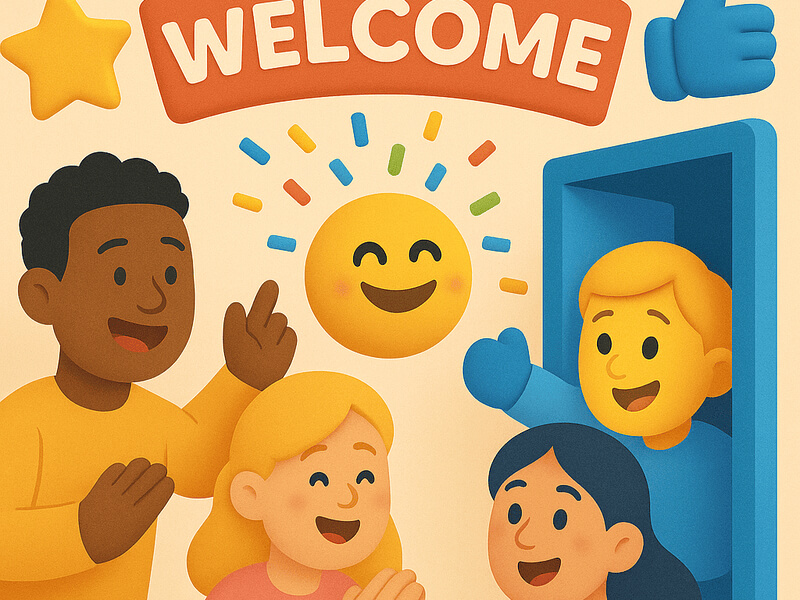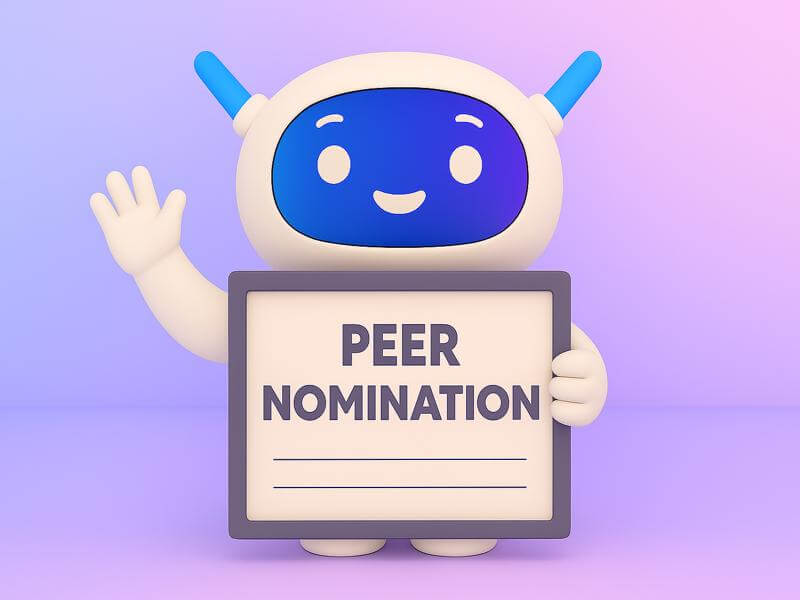
Building meaningful workplace recognition that truly engages employees and drives results can feel overwhelming for organizations trying to move beyond basic appreciation efforts. At Matter, we understand that creating effective peer nomination programs requires more than good intentions, as many companies struggle with inconsistent recognition, participation gaps, and difficulty measuring impact. Traditional recognition approaches often rely heavily on manager-driven processes, leaving untapped potential for peer-to-peer recognition that could transform workplace culture through authentic colleague-to-colleague appreciation.
Peer nomination represents a strategic solution that empowers employees to celebrate one another's achievements, fostering stronger team bonds and a more inclusive recognition culture across all organizational levels. Research from developmental psychology shows that peer recognition has a significant impact on employee engagement, fosters mutual respect, and cultivates positive work environments where meaningful recognition flows naturally between colleagues. This comprehensive guide offers over 40 peer nomination examples, proven templates, and implementation strategies to help organizations establish peer recognition programs that enhance employee morale, foster stronger relationships, and drive measurable business outcomes through genuine workplace appreciation.
What is peer nomination, and how does peer recognition work

Peer nomination is a systematic approach where employees acknowledge and celebrate their colleagues' achievements, contributions, and positive behaviors through formal recognition processes. Unlike manager-to-employee recognition, peer-to-peer recognition fosters a culture of appreciation where team members actively contribute to building a positive workplace culture. This recognition process empowers employees to identify and highlight exceptional performance, collaboration, and leadership qualities among their colleagues, building upon established employee nomination practices that formalize appreciation efforts.
Understanding peer nomination fundamentals in workplace recognition
Peer nomination fundamentals center on creating structured systems that enable employees to recognize peers for specific achievements and behaviors that align with company values. Effective peer recognition programs establish clear criteria for employee nominations, ensuring that meaningful recognition occurs consistently across all levels of the organization. These systems often incorporate digital platforms that make recognition accessible and track participation to maintain program effectiveness.
The foundation of successful peer nomination lies in its ability to foster mutual respect and strengthen relationships between team members. When employees participate in peer recognition, they develop a stronger sense of shared responsibility for creating positive work environments. This collective effort fosters a workplace culture that values collaboration, support, and appreciation for the contributions of others.
How peer-to-peer recognition builds stronger team connections
Peer-to-peer recognition fosters authentic connections by enabling colleagues who work closely together to celebrate each other's successes and positive contributions. This recognition approach builds stronger relationships because it comes from people who directly witness and benefit from excellent performance. Teams that implement regular recognition see improved collaboration, enhanced communication, and increased willingness to support one another.
Research in developmental psychology shows that peer recognition has a significant impact on social status and relationships within groups, consistent with findings from studies on peer relations among middle school youth. Consistent recognition of each other's contributions among team members fosters a positive feedback loop that promotes ongoing excellence and collaboration. This process helps employees feel valued and motivated to maintain high performance standards.
Key components of effective peer recognition programs
Effective peer recognition programs include several essential components that ensure meaningful recognition and sustained engagement. First, clear guidelines help employees understand what behaviors and achievements warrant recognition, maintaining consistency in the recognition process. Second, accessible platforms or systems make it easy for team members to submit nominations and celebrate colleagues regularly.
Training employees on effective nomination writing and recognition practices ensures that peer recognition remains of high quality and impact. Organizations can enhance this training by providing sample write-ups for employee award nomination resources that demonstrate best practices for crafting compelling recognition submissions. Organizations should also establish evaluation criteria that promote fairness and prevent bias in peer-nominated awards.
Additionally, regular program assessment helps organizations track participation, measure employee satisfaction, and adjust processes to improve retention and engagement outcomes.
Why peer nomination and peer-to-peer recognition are important
Peer nomination serves as a cornerstone for building engaged, motivated teams that thrive on collaboration and shared success. Organizations that adopt complete peer recognition systems observe notable enhancements in employee engagement, job satisfaction, and retention rates. This recognition approach creates workplace environments where employees feel genuinely appreciated by those who understand their day-to-day challenges and contributions most intimately.
Building employee engagement through peer recognition examples
Employee engagement flourishes when team members actively participate in recognizing each other's achievements and positive behaviors. Peer recognition examples demonstrate how colleagues can celebrate everything from small daily contributions to major project successes, creating a continuous cycle of appreciation. When employees engage in regular recognition, they develop stronger connections to their work, teams, and organizational goals.
Effective peer recognition examples include celebrating innovative problem-solving approaches, acknowledging exceptional customer service delivery, and highlighting collaborative efforts that drive team successes. These recognition moments boost employee morale by showing that colleagues notice and value each person's unique contributions. Organizations that encourage employees to share specific examples of peer excellence create environments where recognition becomes a natural part of workplace interactions.
Creating an inclusive recognition culture with peer nomination processes
Inclusive recognition culture emerges when peer nomination processes ensure that all employees have opportunities to both give and receive recognition regardless of their role or department. Well-designed peer recognition programs create dedicated spaces where team members can nominate colleagues from different backgrounds, experience levels, and functional areas. This inclusivity helps employees feel valued and ensures that contributions across the organization receive appropriate acknowledgment.
Peer nomination processes that emphasize diversity and inclusion help organizations identify and celebrate different types of excellence, from quiet leadership to innovative thinking. When employees recognize peers across various dimensions of performance, it creates a more comprehensive view of what success looks like within the organization. This approach strengthens relationships between team members from different departments and builds mutual respect across the entire workplace, supported by diverse employee recognition nomination examples that showcase inclusive appreciation practices.
Impact of teamwork recognition on workplace morale and retention
Teamwork recognition through peer nomination has profound effects on workplace morale and employee retention rates. When organizations make recognition a regular part of their culture, employees develop stronger emotional connections to their work environment and colleagues. This emotional investment translates into improved job satisfaction and reduced turnover, particularly among high-performing team members.
Research indicates that individuals who receive consistent acknowledgment from colleagues are more inclined to remain with their firms over the long run and endorse their workplace to others. The positive impact of peer recognition extends beyond individual recipients, creating ripple effects throughout teams and departments. Organizations that prioritize teamwork recognition see improvements in collaboration, communication, and overall business outcomes as employees become more invested in collective success.
12+ peer nomination example templates for workplace recognition

Creating effective peer nomination templates ensures that recognition captures specific achievements and behaviors while maintaining consistency across the organization. These templates serve as guides for employees who want to recognize peers but may need structure to articulate their appreciation effectively. Well-designed templates help employees focus on meaningful recognition that highlights both individual contributions and broader impact on team and organizational success, similar to structured employee nomination form approaches that provide clear frameworks for comprehensive recognition.
Performance-based peer nomination example templates
Template 1: Exceptional goal achievement "I nominate [Colleague] for their outstanding performance in exceeding quarterly targets while maintaining exceptional quality standards. Their dedication and strategic approach resulted in a 15% improvement in team productivity and served as inspiration for other team members to elevate their own performance."
Template 2: Process improvement initiative "[Colleague] deserves recognition for identifying and implementing a streamlined workflow that reduced processing time by 20%. Their initiative demonstrates excellent problem-solving skills and shows how individual contributions can create a positive impact across the entire department."
Template 3: Quality excellence recognition "I want to recognize [Colleague] for consistently delivering work that exceeds quality expectations while helping teammates maintain similar standards. Their attention to detail and willingness to share best practices have elevated our entire team's output quality."
Template 4: Client success achievement "[Colleague] earned this nomination through their exceptional handling of a challenging client situation, turning potential dissatisfaction into a long-term partnership. Their professionalism and solution-focused approach exemplify the positive attitude our organization values."
Leadership and mentorship peer-to-peer award nomination examples
Template 5: Emerging leadership recognition "I nominate [Colleague] for demonstrating natural leadership qualities by guiding our team through a complex project transition. Their ability to communicate clearly and support team members shows the leadership potential that benefits our entire organization."
Template 6: Mentorship excellence award "[Colleague] deserves recognition for their commitment to knowledge sharing and mentoring new team members. Their patient guidance and willingness to invest time in others' development create a stronger, more capable team for everyone."
Template 7: Cross-functional leadership "I want to recognize [Colleague] for their leadership in coordinating efforts between departments to achieve shared objectives. Their collaborative approach and ability to build consensus demonstrate exceptional leadership skills that drive organizational success."
Template 8: Crisis leadership recognition "[Colleague] showed outstanding leadership during our recent system outage by coordinating response efforts and maintaining team morale under pressure. Their calm demeanor and decisive action helped minimize impact and demonstrated true leadership character."
Innovation and problem-solving peer recognition examples
Template 9: Creative solution award "I nominate [Colleague] for developing an innovative approach to our inventory management challenge that reduced waste by 25%. Their creative thinking and willingness to experiment with new ideas show how innovation can drive meaningful business outcomes."
Template 10: Technical innovation recognition "[Colleague] deserves recognition for their innovative use of automation tools that streamlined our reporting process. Their technical expertise and forward-thinking approach saved the team countless hours while improving accuracy and consistency."
Template 11: Process innovation award "I want to recognize [Colleague] for questioning existing procedures and proposing improvements that enhanced our customer onboarding experience. Their innovative mindset and persistence in finding better solutions demonstrate valuable contributions to our continuous improvement efforts."
Template 12: Collaborative innovation recognition "[Colleague] earned this nomination by bringing together diverse perspectives to solve a long-standing operational challenge. Their ability to facilitate innovation through collaboration shows how teamwork and creativity can drive breakthrough solutions."
Customer service excellence recognition examples
Template 13: Customer advocacy award "I nominate [Colleague] for consistently going above and beyond to ensure customer satisfaction while maintaining a positive attitude even in challenging situations. Their dedication to customer success reflects the values our organization strives to embody in every interaction."
Template 14: Service recovery excellence "[Colleague] deserves recognition for their exceptional handling of a complex customer complaint that resulted in renewed trust and continued partnership. Their empathy, problem-solving skills, and persistence demonstrate the customer-first approach that makes all the difference in our success."
10+ peer-to-peer recognition examples for different workplace scenarios
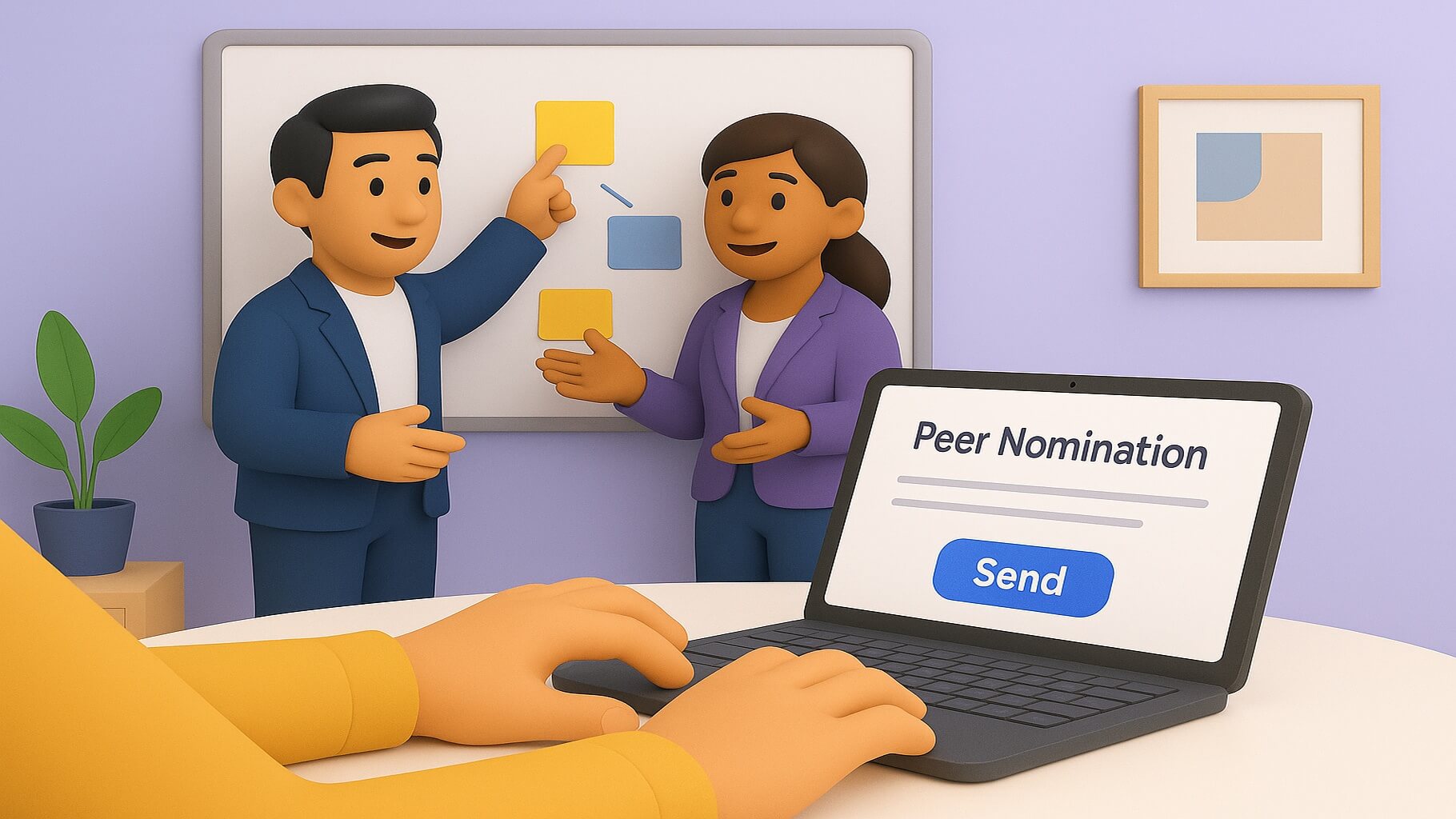
Peer-to-peer recognition examples offer practical frameworks for acknowledging various types of contributions and achievements in diverse workplace situations. These examples demonstrate how meaningful recognition can address everything from daily collaboration to major milestone celebrations. Effective recognition examples help employees understand how to craft messages that resonate with recipients and inspire continued excellence, drawing from established employee nomination examples that showcase best practices for workplace appreciation.
Daily recognition at work examples for team collaboration
Example 1: Meeting facilitation excellence "Thank you for facilitating today's brainstorming session with such skill and energy. Your ability to keep everyone engaged and ensure all voices were heard created an environment where great ideas could flourish. The positive impact of your facilitation style makes our team meetings more productive and enjoyable."
Example 2: Knowledge sharing appreciation "I want to recognize your willingness to share your expertise on the new software implementation. Your patient explanations and helpful documentation have made the transition much smoother for everyone. This kind of knowledge sharing strengthens our entire team's capabilities."
Example 3: Problem-solving support "Your quick thinking and collaborative approach helped us resolve the client issue before it escalated. The way you jumped in to help and offered creative solutions demonstrates the teamwork and positive attitude that make our department successful."
Example 4: Daily excellence recognition "I appreciate how you consistently maintain high standards while supporting teammates who need assistance. Your dependability and eagerness to assist others foster a constructive work atmosphere conducive to collective success."
Project completion and achievement peer recognition examples
Example 5: Project leadership recognition "Your leadership throughout the product launch project was exceptional. You kept everyone motivated, managed timelines effectively, and ensured quality never suffered despite tight deadlines. The project's success reflects your dedication and excellent coordination skills."
Example 6: Cross-team collaboration award "Thank you for your outstanding work coordinating between the marketing and development teams during our website redesign. Your communication skills and attention to detail ensured everyone stayed aligned, and the project exceeded expectations."
Example 7: Quality achievement recognition "Your commitment to quality during the final phases of our certification project was remarkable. The thorough review process you implemented caught potential issues early and ensured we met all requirements on schedule."
Example 8: Innovation implementation award "The innovative approach you brought to our data analysis project transformed how we understand customer behavior. Your creative thinking and technical skills resulted in insights that will guide our strategy for months to come."
Cross-departmental recognizing team members examples
Example 9: Inter-department support "I want to recognize your exceptional support during our budget planning process. Although this wasn't part of your regular responsibilities, you provided valuable insights that helped us make more informed decisions. Your collaborative spirit strengthens our entire organization."
Example 10: Knowledge bridge recognition "Your ability to translate technical concepts for our non-technical team members was invaluable during the system implementation. You helped bridge communication gaps and ensured everyone understood the changes and their benefits."
Example 11: Resource sharing appreciation "Thank you for sharing your team's expertise and resources during our peak season rush. Your department's willingness to collaborate helped us meet customer demands while maintaining service quality. This cooperation exemplifies the mutual respect that makes our organization strong."
Employee recognition write-up examples for peer nominations
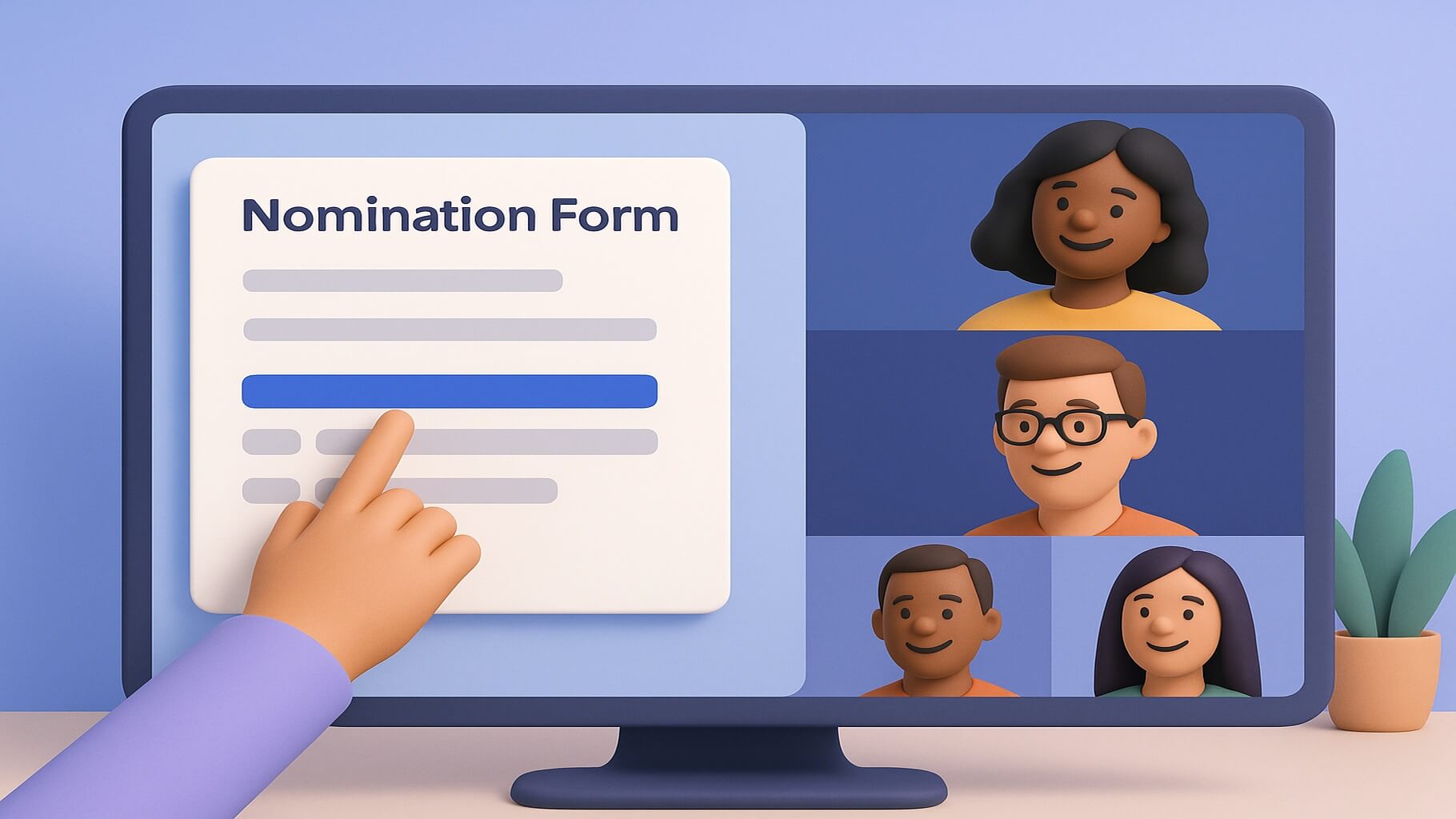
Employee recognition write-ups serve as formal documentation of outstanding performance and contributions that deserve broader organizational acknowledgment. These comprehensive examples offer structured approaches for capturing the full scope of an employee's impact, from specific achievements to their broader influence on team dynamics and the culture of appreciation. Well-crafted recognition write-ups help organizations maintain consistent standards while celebrating diverse types of excellence, building upon proven employee recognition examples that demonstrate effective appreciation practices.
Structured peer nomination example write-ups with impact metrics
Example 1: Performance improvement initiative "I am pleased to nominate [Colleague] for their exceptional work in developing and implementing our new customer feedback system. In the previous quarter, their campaign resulted in a 30% increase in response times and a notable boost in customer satisfaction levels. [Colleague] identified gaps in our existing process, researched best practices, and collaborated with multiple departments to design a solution that addresses both current needs and future growth. Their project management skills ensured smooth implementation with minimal disruption to daily operations. This initiative's beneficial effects surpass immediate measurements, establishing a basis for continuous enhancement of client interactions. [Colleague's] dedication to excellence and innovative thinking demonstrates the kind of leadership that drives organizational success."
Example 2: Team development and mentorship "[Colleague] deserves recognition for their outstanding commitment to developing team capabilities through formal and informal mentoring activities. Over the past six months, they have guided three new team members through onboarding processes while maintaining their own high standards of performance. Their mentoring approach combines technical knowledge sharing with emotional support, creating an environment where new employees feel confident and supported. The team members they have mentored report increased job satisfaction and faster skill development compared to previous onboarding experiences. [Colleague's] investment in knowledge sharing has created a stronger, more resilient team that can handle increased responsibilities and challenges. Their leadership in developing others reflects the company values of growth and collaboration that strengthen our entire organization."
Example 3: Crisis management and problem resolution "I nominate [Colleague] for their exceptional leadership during our recent system outage that threatened to disrupt customer operations. When the crisis occurred, [Colleague] immediately took charge of communication efforts, coordinated technical response teams, and maintained regular updates with affected customers. Their calm demeanor and clear communication helped prevent panic, while their strategic thinking guided the response process that restored service 40% faster than our standard recovery timeline. Throughout the crisis, [Colleague] demonstrated the positive attitude and problem-solving skills that make all the difference in challenging situations. Their ability to maintain team morale while driving results shows the kind of leadership that builds trust and confidence among colleagues and customers alike."
Positive recognition examples for employees demonstrating values
Example 4: Innovation and continuous improvement "[Colleague] exemplifies our organization's commitment to innovation through their development of an automated reporting system that saves the team 15 hours per week. Rather than accepting existing processes as unchangeable, they questioned inefficiencies and proposed solutions that benefit everyone. Their willingness to experiment with new technologies and share learning with teammates demonstrates the growth mindset our organization values. The positive impact of their innovation extends beyond time savings to include improved accuracy and reduced stress for the entire team. [Colleague's] approach to problem-solving shows how individual initiative can create collective benefits that strengthen our competitive position."
Example 5: Customer-focused excellence "I want to recognize [Colleague] for consistently demonstrating our customer-first values through their exceptional service delivery and relationship building. Their approach to client interactions combines professional expertise with genuine care for customer success, resulting in improved satisfaction scores and expanded partnerships. [Colleague] regularly goes beyond basic requirements to understand customer needs and propose solutions that create long-term value. Their positive attitude and solution-focused mindset have transformed challenging customer situations into opportunities for deeper engagement and mutual benefit. The respect and trust they have earned from clients reflects the kind of relationship-building that drives sustainable business growth."
Example of recognition letters for peer-to-peer awards
Example 6: Comprehensive team contribution letter
"Dear Recognition Committee,
I am writing to nominate [Colleague] for the quarterly peer-to-peer award in recognition of their outstanding contributions to our team's success and positive workplace culture. Over the past three months, [Colleague] has consistently demonstrated the collaboration, innovation, and leadership qualities that embody our organizational values.
[Colleague's] technical expertise and willingness to share knowledge have elevated our entire team's capabilities. They have led training sessions on new software tools, created documentation that improves efficiency, and provided patient support to colleagues learning new processes. Their teaching approach combines clear explanations with hands-on guidance, ensuring that knowledge is effectively and lastingly transferred.
Beyond technical contributions, [Colleague] has shown exceptional leadership in fostering team cohesion and mutual respect. During our recent restructuring, they helped maintain team morale by facilitating open communication and organizing informal team-building activities. Their positive attitude and emotional intelligence helped colleagues navigate uncertainty while maintaining productivity and collaboration.
The positive impact of [Colleague's] contributions extends throughout our department and influences cross-functional relationships. Their collaborative approach to problem-solving has enhanced communication between teams and led to more effective project outcomes. Colleagues from other departments frequently seek their input on initiatives, recognizing their ability to provide valuable insights and support.
I strongly recommend [Colleague] for this recognition because they exemplify the peer recognition our organization values while driving meaningful business outcomes. Their combination of technical excellence, leadership skills, and commitment to team success makes them deserving of this honor.
Sincerely, [Nominator Name]"
8+ teamwork recognition and collaboration peer nomination examples

Teamwork recognition celebrates the collaborative spirit that drives organizational success through collective effort and shared responsibility. These peer nomination examples highlight actions and accomplishments that promote team cohesion, improve communication, and nurture a constructive work atmosphere conducive to successful contributions from all members. Effective teamwork recognition helps employees understand how their collaborative efforts impact both immediate team success and broader organizational goals, especially when combined with comprehensive team rewards that reinforce collaborative behaviors.
Team support and assistance recognition example templates
Example 1: Workload distribution support "I want to recognize [Colleague] for their exceptional willingness to assist team members during our busy season. When several colleagues faced competing deadlines, [Colleague] volunteered to take on additional responsibilities while maintaining quality standards for their own work. Their flexible approach and positive attitude helped everyone meet client commitments without compromising delivery quality. This type of team support fosters an environment in which employees feel appreciated and bolstered throughout difficult times."
Example 2: Cross-training initiative recognition "[Colleague] deserves recognition for leading cross-training efforts that have strengthened our team's overall capabilities. They developed comprehensive training materials and conducted sessions that helped team members develop skills in multiple areas. Their investment in information dissemination has fostered a more adaptable workforce capable of responding to shifting objectives and providing mutual assistance more efficiently. This initiative demonstrates the collaborative leadership that builds stronger, more resilient teams."
Example 3: New employee integration support "I nominate [Colleague] for their outstanding work helping new team members integrate successfully into our department culture. Their patient guidance, willingness to answer questions, and inclusive approach help new employees feel welcome and supported from their first day. The positive impact of their mentoring extends beyond initial onboarding to create lasting relationships that strengthen team cohesion and effectiveness."
Conflict resolution and problem-solving peer recognition examples
Example 4: Communication bridge building "[Colleague] showed exceptional skill in facilitating difficult conversations between team members with different perspectives on our project approach. Rather than avoiding the tension, they created a safe space for open dialogue and helped everyone find common ground. Their emotional intelligence and communication skills transformed potential conflict into productive collaboration that improved our final outcome."
Example 5: Process improvement through collaboration "I want to recognize [Colleague] for their role in resolving our recurring workflow conflicts through collaborative problem-solving. They brought together stakeholders from different areas, facilitated discussions to identify root causes, and helped develop solutions that work for everyone. Their systematic approach to conflict resolution has created more efficient processes and better working relationships across departments."
Example 6: Resource allocation resolution "[Colleague] demonstrated excellent problem-solving skills when competing priorities threatened to derail our project timeline. They facilitated discussions between affected teams, helped identify creative solutions for resource sharing, and ensured that everyone felt heard in the decision-making process. Their collaborative approach to conflict resolution maintains team morale while achieving practical solutions."
Knowledge sharing and mentoring recognition examples
Example 7: Technical expertise sharing "I nominate [Colleague] for their exceptional commitment to knowledge sharing that has elevated our entire team's technical capabilities. They regularly conduct informal training sessions, create helpful documentation, and provide patient support when colleagues encounter challenges. Their generous sharing of expertise creates a learning environment where everyone can grow and contribute more effectively."
Example 8: Best practices documentation "[Colleague] deserves recognition for developing comprehensive best practices guides that help team members perform at higher levels. Their systematic approach to capturing and sharing knowledge ensures that successful methods are preserved and accessible to everyone. This documentation has reduced onboarding time for new employees while helping experienced team members refine their approaches."
Example 9: Reverse mentoring initiative "I want to recognize [Colleague] for their innovative approach to mentoring that includes learning from newer team members about emerging technologies and fresh perspectives. Their modest approach to knowledge dissemination fosters an atmosphere in which all individuals feel appreciated for their distinct contributions. This reverse mentoring model has strengthened relationships across experience levels while keeping our team current with industry developments."
Peer-to-peer recognition software and platform options
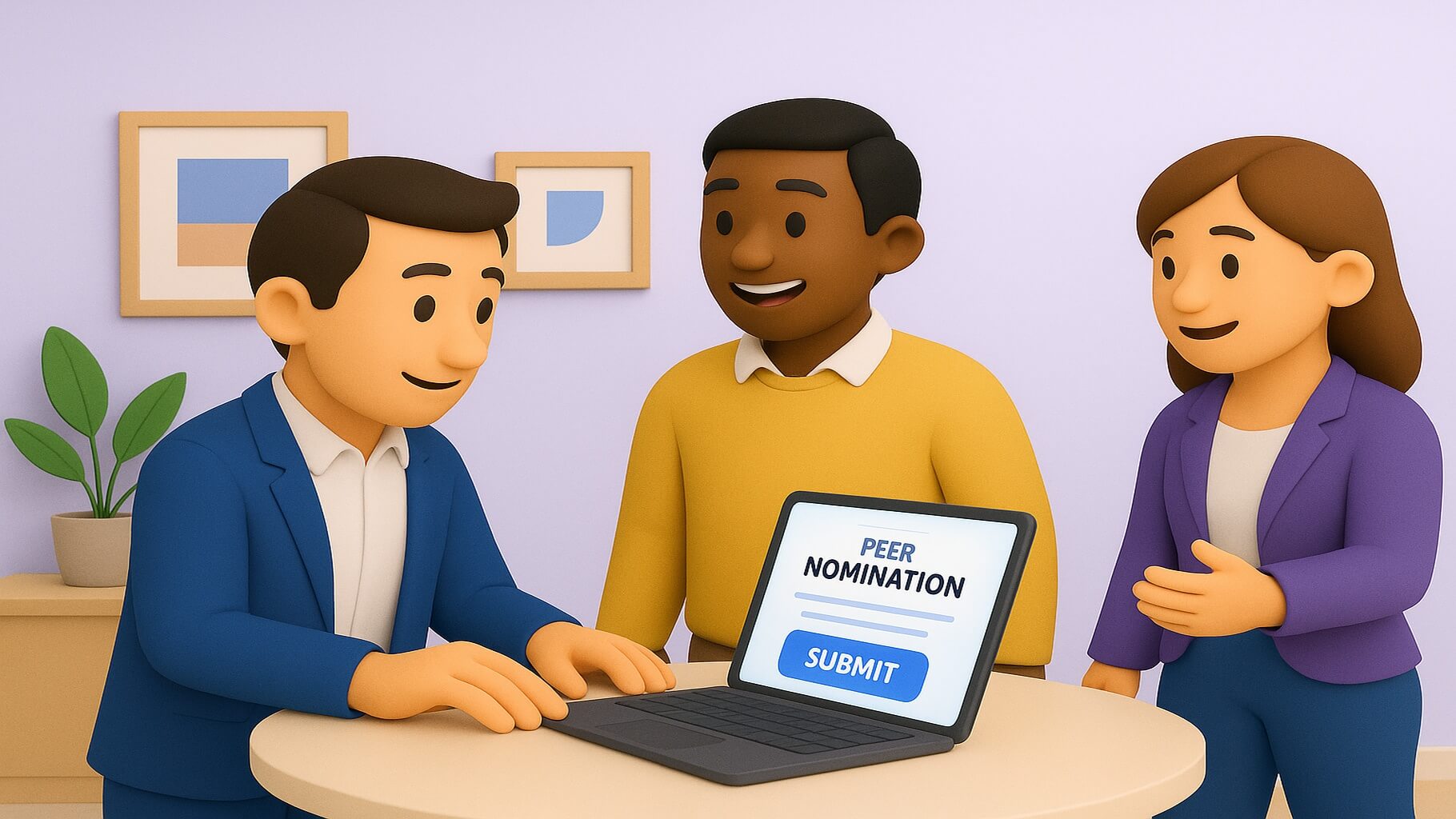
Modern peer-to-peer recognition software offers organizations powerful tools to facilitate meaningful recognition, track participation, and measure program effectiveness. These platforms transform traditional recognition processes by making peer recognition accessible, consistent, and engaging for employees across all departments and locations. Choosing the right recognition platform requires understanding key features, integration capabilities, and how digital solutions compare to traditional recognition methods.
Features to look for in peer-to-peer recognition platform solution
Essential peer-to-peer recognition platform features include user-friendly interfaces that make recognition simple and accessible for all employees, regardless of technical expertise. Effective platforms provide customizable templates that guide users in creating meaningful recognition while maintaining consistency across the organization. Integration features with current workplace technologies guarantee that recognition is seamlessly incorporated into daily activities instead of being an added encumbrance.
Core platform features to prioritize:
- User-friendly interfaces that make recognition simple and accessible for all employees, regardless of technical expertise or experience level.
- Customizable templates that guide users in creating meaningful recognition while maintaining organizational consistency and quality standards
- Seamless integration capabilities with existing workplace tools, ensuring recognition becomes part of daily workflows rather than additional burdens.
- Advanced analytics and reporting that track participation rates, identify recognition trends, and measure program effectiveness on employee engagement and retention.
- Mobile accessibility ensures that remote employees and mobile-first workers can participate fully in recognition activities from any device.
Advanced functionality requirements:
- Automation features that streamline workflows through reminders, peer-nominated awards facilitation, and consistent recognition maintenance over time
- Comprehensive customization options allow organizations to align recognition with company values and create experiences reflecting unique appreciation cultures
- Robust security and privacy features that protect employee information while enabling transparent recognition that builds trust and engagement
- Continuous improvement insights that help leadership understand the positive impact of peer recognition on workplace culture and business outcomes
These features enable organizations to create recognition experiences that are both meaningful for employees and manageable for administrators while supporting long-term program success.
Comparing digital vs traditional peer nomination methods
Digital peer nomination platforms offer significant advantages over traditional paper-based or email recognition systems in terms of accessibility, tracking, and engagement. Traditional methods often result in inconsistent participation because they require more effort to complete and may not reach all employees effectively. Digital platforms make recognition immediate and visible, creating positive feedback loops that encourage continued participation.
Key advantages of digital platforms include:
- Enhanced accessibility and engagement with immediate, visible recognition that creates positive feedback loops, encouraging continued participation
- Comprehensive tracking and analytics that enable organizations to understand participation patterns and measure program effectiveness more effectively than traditional methods
- Improved scalability makes digital solutions particularly valuable for larger organizations, where traditional methods become impractical to manage consistently.
- Remote team inclusion ensures that hybrid and remote employees can participate equally in recognition activities regardless of physical location
Traditional method considerations:
- Personal touch benefits, as some employees may prefer handwritten recognition for its perceived authenticity and personal connection
- Participation challenges due to higher effort requirements and potential difficulty reaching all employees effectively
- Limited analytics capabilities make it challenging to track patterns or demonstrate return on investment
Integration capabilities for peer-to-peer recognition software
Modern recognition platforms integrate seamlessly with popular workplace communication tools to embed recognition into existing workflows rather than creating additional tasks for employees. These integration capabilities eliminate friction while ensuring that peer recognition becomes a natural part of daily work activities.
Essential integration types include:
- Workplace communication solutions, such Slack, Microsoft Teams, and email systems, that integrate recognition seamlessly into established workflows
- Calendar integrations that automate celebration reminders for work anniversaries, birthdays, and other important milestones without manual tracking
- Human resources information systems enable automatic employee data updates, maintain accurate organizational charts, and report relationships
- Analytics connections that link recognition patterns with HR metrics, including performance reviews, engagement surveys, and retention rates
- Project management tool integrations allowing recognition to be tied directly to project milestones and successful initiative completions
- Security features, including single sign-on capabilities that simplify access while maintaining organizational security standards
Organizations evaluating different recognition software options should prioritize platforms that offer comprehensive integration capabilities to ensure seamless adoption and sustained usage across their workforce.
How to implement peer nomination programs in your workplace
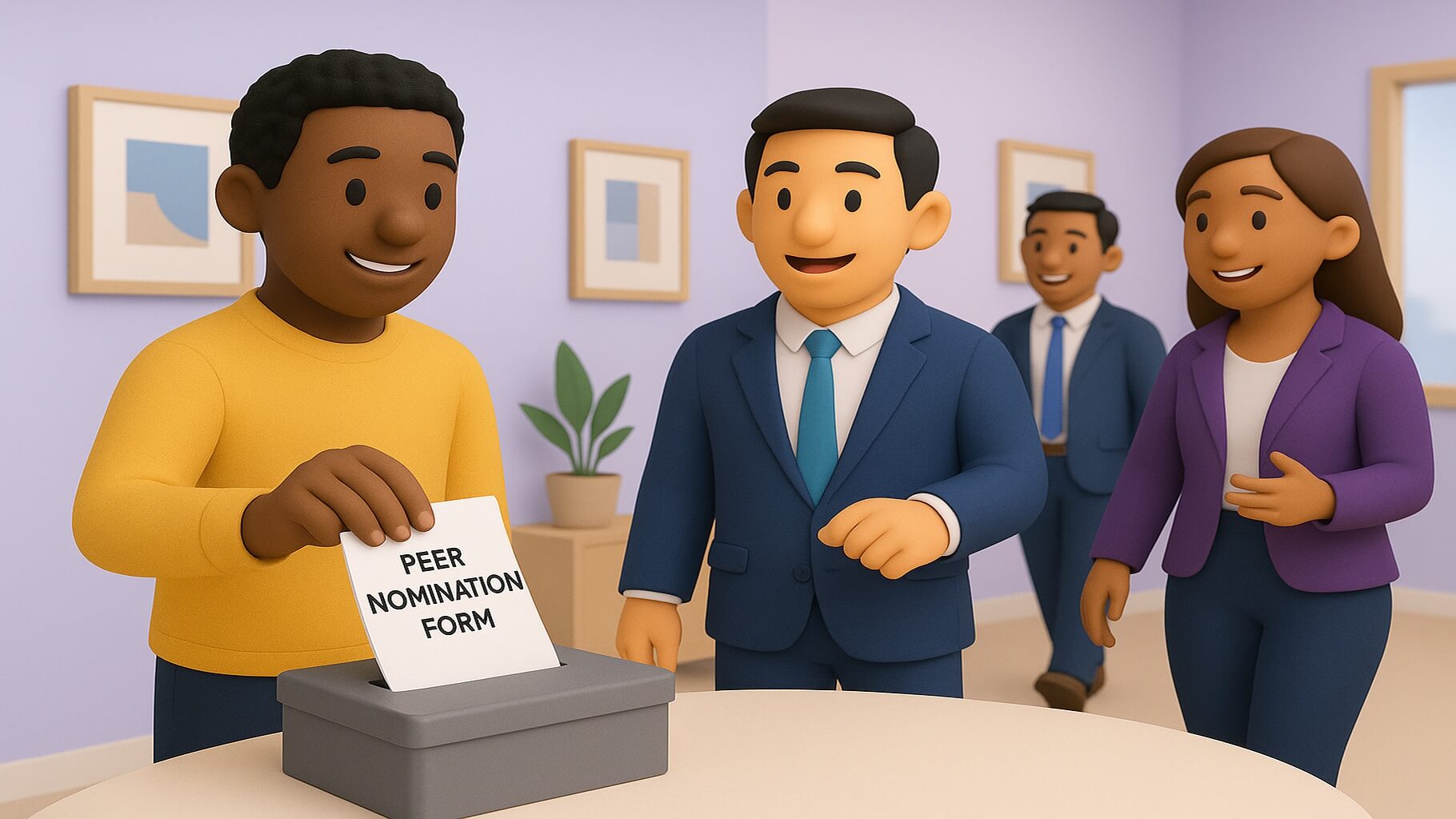
Successful implementation of peer nomination programs needs meticulous preparation, explicit communication, and continuous assistance to embed recognition within corporate culture. Organizations must establish frameworks that encourage meaningful participation while maintaining fairness and consistency in recognition processes. Effective implementation strategies address both the technical aspects of program setup and the cultural changes needed to sustain long-term success.
Setting up peer recognition processes and guidelines
Establishing clear peer recognition processes begins with defining what types of behaviors and achievements warrant recognition within the organizational context. Guidelines should specify criteria for nominations while providing flexibility for recognizing diverse contributions across different roles and departments. These guidelines help maintain consistency in recognition quality while preventing potential bias or favoritism that could undermine program effectiveness.
Essential setup components include:
- Clear recognition criteria that define behaviors and achievements worthy of peer nomination while allowing flexibility for diverse contributions
- Comprehensive communication strategies ensuring all employees understand submission processes, required information, and evaluation procedures
- Structured timelines for nomination submissions, review processes, and recognition announcements to maintain program momentum
- Feedback mechanisms through surveys and focus groups that enable continuous improvement based on employee input and performance data
Training employees on effective peer nomination example creation
Comprehensive training programs teach employees how to write compelling peer nomination examples that capture specific achievements and their broader impact on team and organizational success. Effective training includes examples of strong nominations alongside explanations of what makes them powerful, helping employees understand how to articulate appreciation in a meaningful way. Role-playing exercises and practice sessions give employees confidence in their ability to recognize peers effectively.
Training program elements include:
- Practical workshops with strong employee nomination examples and explanations of effective recognition writing techniques
- Challenge-focused sessions addressing reluctance to nominate peers, avoiding generic praise, and ensuring authentic recognition.
- Recognition identification training helps employees spot various contribution types, from major achievements to daily excellence.
- Ongoing support systems through refresher training, writing workshops, and peer mentoring to maintain nomination quality standards
Creating evaluation criteria for peer-to-peer award nominations
Developing fair evaluation criteria for peer-to-peer award nominations ensures that recognition decisions are transparent, consistent, and aligned with organizational values. Evaluation criteria should strike a balance between objective achievements and qualitative factors, such as collaboration, leadership, and a positive impact on workplace culture. Clear scoring rubrics help evaluation committees make consistent decisions while reducing potential bias.
Key evaluation framework components include:
- Balanced scoring criteria combining objective achievements with qualitative factors like collaboration and leadership impact
- Diverse evaluation committees with representatives from different departments and organizational levels for varied perspectives
- Committee training programs focused on the application of evaluation criteria and bias prevention to ensure fair assessment.
- Transparent documentation processes, providing feedback on unsuccessful nominations while celebrating successful recognition, to build program trust
Organizations that successfully integrate peer nomination with broader employee incentive programs often see enhanced participation and more meaningful recognition outcomes.
How Matter can help with peer nomination and peer-to-peer recognition
Matter transforms peer nomination and peer-to-peer recognition through innovative automation, customization, and analytics that make meaningful recognition effortless and impactful. The technology interfaces effortlessly with Slack and Microsoft Teams, making peer recognition an inherent aspect of daily processes instead of an extraneous activity. Matter's approach to recognition emphasizes authenticity and consistency while providing organizations with powerful tools to measure and improve their culture of appreciation.
Streamlined peer nomination workflows with automated processes
Matter's automated workflows eliminate administrative burden from peer nomination processes while ensuring that recognition opportunities never get overlooked. The platform's automated features help organizations maintain consistency in their recognition efforts without requiring constant manual intervention. These automation capabilities create comprehensive recognition experiences that celebrate both achievements and important personal milestones.
Key automation features include:
- Feedback Friday reminds employees to participate in regular recognition while maintaining authenticity
- Automated milestone celebrations for work anniversaries and birthdays without manual tracking
- Self-serve data collection that gathers celebration dates efficiently while respecting privacy preferences
- Streamlined nomination workflows that coordinate collection, review, and announcement processes for peer-nominated awards
Customizable peer recognition examples and templates
Matter offers extensive customization options, enabling organizations to create peer recognition examples and templates tailored to their unique company values and culture. The platform's beautiful kudos cards can be customized for different types of recognition, ensuring that each recognition moment feels personal and meaningful. These customization capabilities help organizations maintain brand consistency while celebrating diverse contributions.
Customization options include:
- Customizable kudos cards for performance achievements, collaboration excellence, and personal milestones
- Template libraries that provide starting points for effective peer nomination writing
- Flexible categories for highlighting specific behaviors like innovation, leadership, customer service, and teamwork
- Visual design capabilities with custom graphics, company branding, and personalized messaging options
Analytics and reporting for peer to peer-to-peer recognition platform success
Matter's comprehensive analytics provide organizations with detailed insights into peer recognition patterns, participation rates, and program effectiveness across departments and teams. These analytics help organizations track participation to identify areas where additional support may be needed to ensure equitable distribution of recognition. Advanced reporting capabilities enable leadership to understand the positive impact of peer recognition on employee engagement and organizational culture.
Analytics and reporting features include:
- Participation tracking across departments and teams to ensure equitable recognition distribution
- Recognition pattern analysis that correlates with improved performance, retention, and job satisfaction outcomes
- Giving and receiving metrics to ensure all employees have opportunities to participate in peer recognition activities
- Coin-based reward system that resets weekly to encourage authentic recognition and prevent hoarding behaviors
- Program evaluation tools that provide metrics on recognition frequency, quality, and impact over time
FAQs about peer nomination and peer recognition
Q: What makes an effective peer nomination example?
A: Effective peer nomination examples include specific achievements, measurable impact, and clear connections to company values. Strong nominations describe particular behaviors or accomplishments rather than general praise, explain how the nominee's actions benefited the team or organization, and demonstrate alignment with organizational goals and culture.
Q: How often should peer-to-peer recognition occur in the workplace?
A: Peer-to-peer recognition should happen regularly throughout the year, with daily informal recognition complemented by formal monthly or quarterly peer-nominated awards. Consistency matters more than frequency, so organizations should establish sustainable recognition rhythms that employees can maintain over the long term, while ensuring meaningful recognition occurs consistently.
Q: What's the difference between peer nomination and manager recognition?
A: Peer nomination comes from colleagues at similar organizational levels who work closely together, while manager recognition flows from supervisors to direct reports. Peer recognition often focuses on collaboration, support, and day-to-day excellence that managers might not directly observe, creating a more comprehensive recognition experience for employees.
Q: How do you ensure fairness in peer-to-peer award nomination examples?
A: Fairness in peer-to-peer award nominations requires clear evaluation criteria, diverse review committees, and transparent processes that prevent bias. Organizations should provide guidelines for effective nominations, train evaluation committees on fair assessment practices, and regularly review participation patterns to ensure equitable distribution of recognition across all employee groups.
Q: What peer-to-peer recognition software features are most important?
A: Essential recognition software features include ease of use, integration with existing workplace tools, customizable templates, and comprehensive analytics. Organizations should prioritize platforms that make recognition accessible to all employees while providing insights into program effectiveness and participation patterns that support continuous improvement.
Q: Can peer recognition examples be adapted for remote teams?
A: Peer recognition examples adapt well to remote environments through digital platforms that facilitate virtual recognition, video messages, and online celebration events. Remote teams can use collaborative tools, virtual recognition walls, and digital peer nomination processes to maintain a strong recognition culture despite physical distance.
Final thoughts about peer nomination and peer-to-peer recognition
Peer nomination exemplifies a revolutionary method for cultivating a working culture founded on mutual respect, joint achievement, and collaborative pursuit of organizational greatness. When implemented thoughtfully, peer-to-peer recognition programs create environments where employees feel valued not just by leadership but by the colleagues who work alongside them daily. This comprehensive recognition approach fosters stronger relationships, enhances employee engagement, and drives business outcomes through improved collaboration and increased morale.
The journey toward implementing effective peer recognition requires commitment to creating systems that are fair, meaningful, and sustainable over time. Organizations that invest in proper training, clear guidelines, and supportive technology foster a culture of recognition, where appreciation becomes a natural part of workplace interactions. The beneficial effects of these programs transcend individual acknowledgment, fundamentally altering team collaboration, communication, and mutual support for achievement.
Success in peer nomination programs depends on leadership commitment, employee engagement, and continuous improvement based on feedback and program performance data. Organizations that regard peer recognition as a strategic endeavor rather than merely a program experience enhanced employee happiness, retention, and overall business performance. The investment in peer-to-peer recognition pays dividends through stronger teams, improved morale, and enhanced organizational culture that attracts and retains top talent.
Ready to take your peer nomination and peer-to-peer recognition strategy to the next level? Schedule a demo with a Matter expert today and discover how the right tools can help you recognize great work, boost engagement, and support long-term business success.






















